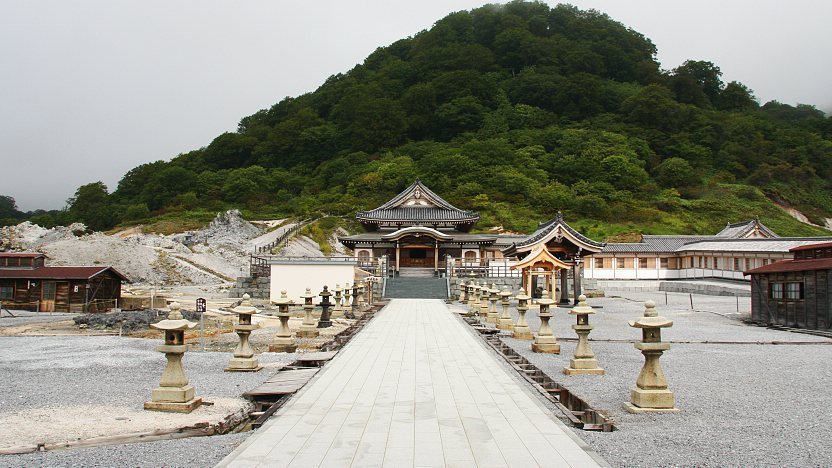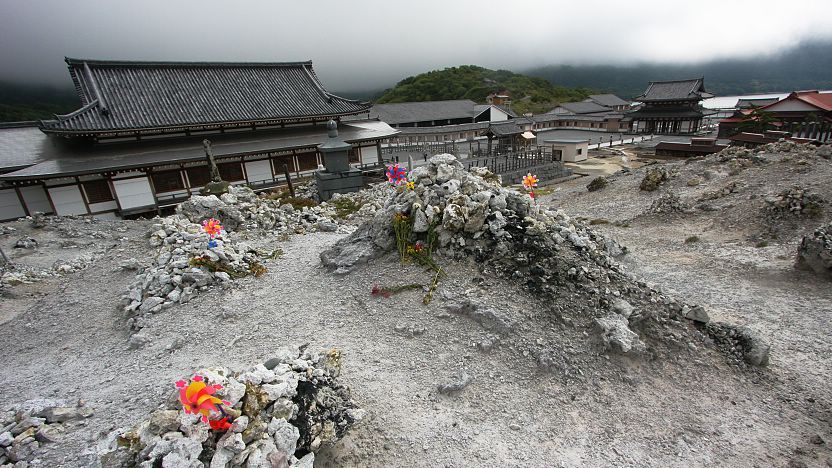Osorezan (Mount Osore)

Mount Osorezan (恐山) is ranked along with Koyasan and Hieizan as one of Japan's three most sacred places. It was discovered over 1000 years ago by a Buddhist priest in search of a sacred mountain that resembles the world of Buddha. Today, it is the site of Bodaiji Temple.
Osorezan is translated as "Fear Mountain", a name that comes in part from the mountain's exceptional landscape. The area is rich in volcanic activity, and a strong smell of sulfur permeates the air. The ground is gray and barren and marked by openings that steam, bubble and blow hot water. Lake Usori, located next to the temple, is colored various shades of blue due to its high sulfur content.

Osorezan is also known as the entrance to afterlife, because it features geographical elements similar to descriptions of Buddhist hell and paradise, including eight surrounding peaks and a river, Sanzu no Kawa, which has to be crossed by all dead souls on their way to afterlife and is often compared to the River Styx of ancient Greek mythology.
Among the souls trying to cross the river are the souls of dead children and unborn babies who build piles of pebbles along the riverbed (Sai no Kawara) in an attempt to get to the other side. They are supported by Jizo, a popular Bodhisattva of Japanese Buddhism, who protects the souls from evil demons, which constantly try to destroy the piles of pebbles.

Statues of Jizo are commonplace around Osorezan, as are piles of stones and pebbles. The pebbles are offerings to Jizo by parents of dead children in the hope that he will use the stones to help their children gain access to paradise. Brightly colored toy windmills are another common offering frequently seen around Osorezan's grounds.
Every year, Bodaiji's festival (July 20 to 24) attracts the bereaved and those hoping to communicate with lost loved ones through mediums, known as Itako. Itako are blind women who have undergone extensive spiritual training. In order to commune with the dead, they perform austere purification rituals for three months prior to the event and enter into a deep, prolonged trance during the festival.

Despite its remote location, Osorezan is a well known destination, and the temple is equipped with a modern overnight lodging that allows overnight guests to spend the night on the mountain, enjoy a vegetarian, alcohol-free dinner and breakfast and participate in the morning prayers. Both overnight and day visitors to the temple can use the hot spring baths located on the temple grounds.
Walking paths crisscross Bodaiji's unique temple grounds, affording visitors plenty of opportunity to stroll around the site and take in the scenery. A walk along the shores of Lake Usori is recommended, although visitors should avoid the poisonous water.

Getting there and around

Buses operate roughly every 3 hours between Shimokita Station, Mutsu Bus Terminal and Osorezan. The one way trip from the station to Osorezan takes 45 minutes and costs 810 yen. No buses operate from November through April, when Bodaiji Temple is closed.
How to get to and around Shimokita Peninsula

Hours and Fees
Hours
Admission ends 30 minutes before closing.
Closed
Admission
Questions? Ask in our forum.


